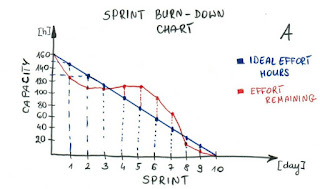5 Agile metrics: Key for sprint success
Agile software development is not
an easy methodology to adopt. There are lot of things which Agile demands and
asks for faster execution and more micro level management .So traditional
metrics which yields results in traditional software development may not be the
best indicator .Agile development I would say more a mindset change rather than
a methodological change .So the metrics which would help in defining the health
of sprint are:-
1.Burndown chart:-Burndown chart is representation of amount of work
completed across time. It is useful for predicting when all of the work will
be completed. It gives a predictability variant and indicates to scrum
master about the progress of sprint. Normally work in agile is computed in form
of story points
2.Capacity:-This is one of key metrics which needs to be computed
in start of sprint and needs to be computed in planning ceremony of
sprint.Based on the capacity scrum master and project teams discuss and take up
the user stories for implementation.Let me give you an example of how capacity
is calculated.
Imagine scrum team is of 5 team
members and the sprint duration is of 2 weeks
Since 2 weeks so it would be 10
days .Working hours per day are 9 .Working hours per week would be 90
1.Actual working hours since
there are 5 team members it would be=90*5=540 hrs per week
2.Daily scrum of 15 mins for 10
days for 5 team members =12.5 (0.25*10*5)hrs
3.Technical meetings and sprint
ceremonies excluding daily scrum=20hrs
4.Any planned leaves &
holidays (Ex :1.2 team members are going on 1 day leave)=18hrs
So Capacity of team is =540-(5+20+18)=497hrs.Based on the actual
capacity team decides and takes user stories for completion of sprint.
Available capacity is one of the key indicators for planning a sprint which is
accurate and precise.
3.Work item count: This is typically the scrum board or Kanban board
which projects the no of tasks,user stories which are in Open,In
progress,Closed,Blocked and Resolved states. The states can vary across scrum
teams but it is recommended to be kept simple .Various representations of work
items can be added
Type of work item (Eg Defect,User story,Requirement etc)
Type of work item (Eg Defect,User story,Requirement etc)
Count
of work items with respect to status etc (CFD-Cummulative Flow Diagram)
4.Open Age and Cycle time : Open Age and Cycle time are one of key metrics for maintenance and bug
fixing projects. It can also be used in Agile projects for finding out the impediments
and blockers.Ex imagine if in a scrum the user story is taking too long for
closing then metrics like Open Age and Cycle tine will help and give early indicator to scrum
master about the work item may not be completed in that sprint .Cycle time and
Open age has a direct connection to productivity. The shorter the cycle time, the
more things are getting done in a given time box.
5.Defect Density:-Defect density is also one of key indicators for
Agile development.Agile principle Comprehensive documentation over Detailed
documentation actually stresses over quality rather than quantity.So reviewing
of requirements,design by architect or senior person in team becomes key
indicator for the quality of work.Defect density plays a pivotal role in
identifying the same








Comments
Post a Comment